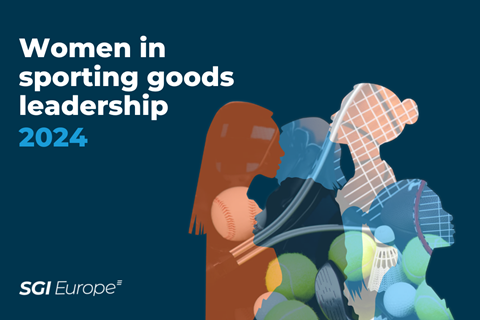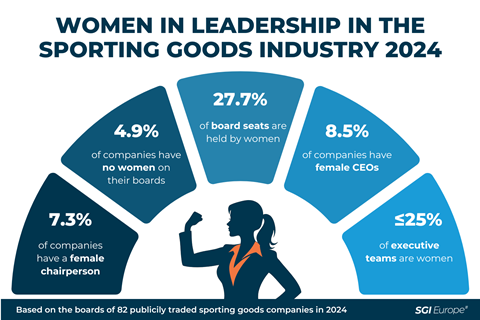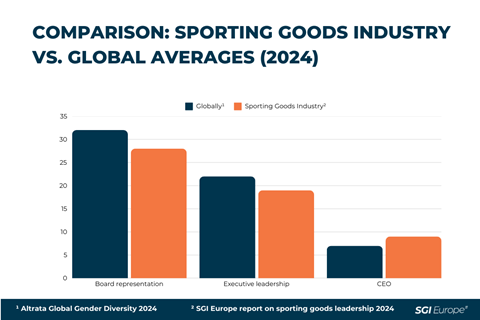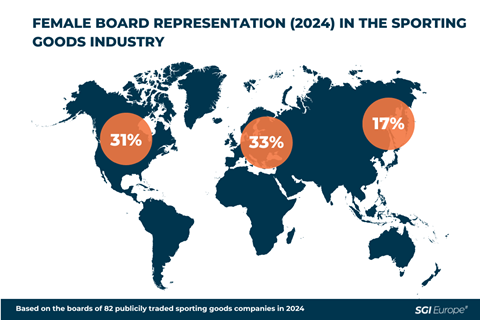Despite some hard-fought gains, women in the sporting goods industry continue to hit roadblocks on their way to the top. Our 2024 survey of 82 publicly traded brands shows a slow but steady rise in female representation on boards and among CEOs. Yet, when stacked against global trends from Altrata, McKinsey, and the World Economic Forum, the data makes one thing clear: true gender parity is still a long way off.

Following up on our 2023 report, we expanded our analysis to 82 publicly traded sporting goods companies worldwide. We focused on key metrics: the number of female directors, the presence of female board chairs, and how many of these companies are led by female CEOs.
The results? Some movement, but not nearly enough. Board representation is inching forward, but executive teams still lag far behind. Global data from Altrata, McKinsey, and the World Economic Forum confirm that, while the tide is shifting, women remain significantly underrepresented at the highest levels of decision-making.
In this article, we compare the sporting goods sector to broader business trends, highlighting where progress has been made and where more work remains to ensure greater diversity.
Jump to a topic or read the full article
- Board structure and gender in the sporting goods world (2024)
- The gender breakdown of executive teams
- How does female leadership in the sporting goods industry compare with the rest of the business world?
- Why board gender diversity matters and how diversity improves business performance
- Sporting goods industry and the tipping point for female directors
- Global disparities in the board room
- A continued call for more female decision makers
- What’s next for gender equality?
- How did we get these numbers?
Board structure and gender in the sporting goods world (2024)

Our latest survey of 82 publicly traded companies reveals:
-
4 companies (4.9%) have no women on their boards.
-
Women hold 27.7% of board seats —slightly below last year’s 27.9% but still approaching one-third.
-
The median percentage of women on boards is 28.6%. Half of companies sit above this threshold, half below.
-
Foot Locker leads the way with a board that is 54.5% female.
-
Only 6 of 82 companies (7.3%) have a female chairperson.
While these figures show moderate improvement (especially in reducing zero-female-director boards), they underscore the need to accelerate momentum if the industry wants to keep up with (or surpass) the global pace of change.
The gender breakdown of executive teams
The gap between board representation and executive leadership remains stubbornly wide:
-
Only 7 of 82 companies (8.5%) have female CEOs, up slightly from last year’s 6.1%.
-
Just two companies —Genesco and Johnson Outdoors—have both a female CEO and a female board chair.
-
Many companies still report executive teams with 25% or fewer women, a stagnation from 2023.
This ongoing trend aligns with broader workforce studies from McKinsey (2024): women are consistently under-promoted at early career stages, limiting their rise to top leadership. Until that changes, the pipeline to executive positions will remain weak.
How does female leadership in the sporting goods industry compare with the rest of the business world?

Compared to the broader business world, the sporting goods sector still has work to do:
-
Board representation: Women hold 32% of board seats in major listed companies across 20 economies (Altrata 2024), while the sporting goods sector trails at 27.7%.
-
Executive leadership:22% of execuive leading roles in large companies worldwide are occupied by women (Altrata 2024), compared to 19% in the sporting goods industry.
-
CEO representation: Women make up only 6.5% of CEOs globally (Altrata 2024), while the sporting goods industry reports 8.5% female CEOs—a slight improvement, but still a stark minority.
As in our 2023 article, female leadership in the sporting goods sector has improved, but not dramatically. It reflects the broader business trend: progress is real but incremental, and significant hurdles remain in moving from boardroom representation to executive power
Why board gender diversity matters
There is a growing body of research – spanning from Credit Suisse and MSCI – indicating a link between women in senior management and better organizational performance. Credit Suisse’s landmark report found that businesses with a higher percentage of women in top management show:
-
Superior sales growth
-
Higher cash flow returns on investments
-
Lower leverage
Likewise, MSCI reported that companies with three or more women on the board (the “magic number” or “tipping point”) saw gains in both return on equity (ROE) and earnings per share (EPS). Academic and industry research attributes this to diverse perspectives, improved decision-making, more effective risk management, and greater innovation.
Companies with more women in leadership benefit from higher innovation, stronger reputations, and better ESG (environmental, social, and governance) scores. According to the World Economic Forum (2024), a diverse and inclusive culture is also essential for long-term talent retention, as women gravitate to employers demonstrating strong support for female career progression.
Sporting goods industry and the “tipping point” for female directors
Independent research from MSCI suggests that having at least three women directors often marks a tipping point for realizing diversity’s full benefits. How does the sporting goods industry measure up? We cross-referenced our latest board composition data with current market capitalization standings for sporting goods companies and noticed the following:
-
Among the top 10 companies by market capitalization, 70% meet or exceed this threshold (Nike, Lululemon, Adidas, Deckers, Dick’s Sporting Goods, Amer Sports, and Moncler).
-
Some big names—Garmin, Anta, and On Holding—have strong female board ratios (25-32%) but haven’t yet hit the three-woman mark.
-
Among smaller companies (ranked 75th or lower), only 33% surpass the three-woman benchmark.
While correlation does not prove causation, this aligns with international research linking diverse leadership teams to stronger overall results. The companies making intentional efforts to recruit and retain top female talent are setting themselves up for stronger long-term performance.
Global disparities in the board room

Beyond individual success stories, our findings reveal clear regional distinctions in the journey toward gender-balanced boards. Among the companies in our dataset:
-
Europe: Female board representation averages 32.9%, driven by regulatory efforts in countries like France and Germany.
-
North America (dominated by the U.S. and some Canadian firms): Sits around 31%, buoyed by leaders like Foot Locker but dragged down by persistently low-diversity companies.
-
Asia: Lags at 17%, with a mix of all-male boards and progressive firms pushing toward 40% representation. Despite rapid economic growth, cultural and institutional barriers still deter greater female participation at the top.
-
South America and Oceania were excluded from this breakdown due to having too few publicly traded sporting goods firms in our sample to draw meaningful comparisons.
These disparities underscore the need for both universal best practices and locally tailored strategies to drive change. Legislative frameworks, social norms, and corporate policies each play a role in either fueling or stalling progress. Strengthening female leadership, therefore, must consider both universal best practices—like transparent promotions and debiasing strategies—and the unique local realities each business faces.
A continued call for more female decision makers
Although the industry’s overall picture has not shifted dramatically since 2023, individual companies continue to break new ground. Super Retail Group in Australia, for instance, now reports a board that is 50 percent female, joining others like BasicNet (Italy) and Peloton (U.S.) in achieving perfect or near-perfect gender parity. Meanwhile, Foot Locker stands out with a board that is 55 percent female, proving that well-balanced governance is fully attainable. Yet a portion of firms still have no female representation at all, failing to include women in key decision-making roles.
As sporting goods brands come to grips with these challenges, Josée Larocque, newly appointed leader at Elevate Outdoor Collective, shared her perspective in an exclusive SGI Europe interview. She pointed out that while diligence and performance matter greatly, systemic biases persist in a largely male-dominated sector:
Until there are more women in the industry and in leadership roles, a woman will rarely be the first or obvious choice for the ‘big’ roles. We must change that because a male dominated culture sure doesn’t make sense from a commercial perspective where women continue to grow their societal and economic impact. It just feels outdated and out of touch, and no one wants to be a part of that past, certainly not the skiers, riders, and outdoor enthusiasts who are our customers.
— Josée Larocque, Elevate Outdoor Collective
Larocque’s remarks emphasize the “circular equation” in leadership progression: if women remain scarce at the top, there are fewer mentors and sponsors to champion other women for higher positions. Companies then lose out on an entire talent pool who could propel them forward. Ultimately, cultivating diversity goes beyond individual drive—true inclusivity requires committed organizational support and a cultural shift that values female leadership at every level.
What’s next for gender equality in sporting goods leadership?
At the current pace, global board-level parity could be achieved by 2034 (according to Altrata), but CEO equality may take until the 2060s. The World Economic Forum estimates it could take 134 years to fully close the gender gap.
As these statistics show, there’s much work ahead. What can companies do now?
-
Debias hiring and promotions: Expand candidate pools, set clear evaluation criteria, and provide bias training.
-
Develop female talent pipelines: Promote women into roles that traditionally lead to executive positions.
-
Support flexible work structures: Recognize that work-life balance policies benefit all employees, but are especially crucial for women.
-
Invest in mentorship and sponsorship: Strong networks help women advance at every career stage.
How did we get these numbers?
This year, we analyzed 82 publicly traded sporting goods companies, as listed in our Global Industry Stock Market Performers database. Board composition data comes from publicly accessible sources on each company’s investor relations or corporate governance pages. For the purposes of this article, “women” are individuals using she/her pronouns; no non-binary individuals were listed in these senior roles.
All aggregated statistics reflect the status of the boards and executive teams as of Q4 2024. To read last year’s findings, check out our 2023 Women in Leadership article.
References & further reading
Altrata (2024). Global Gender Diversity 2024. Link
McKinsey & LeanIn.Org (2024). Women in the Workplace: The 10th-anniversary report. Link
World Economic Forum (2024). Global Gender Gap Report 2024. Link
Credit Suisse (2016). The CS Gender 3000: The Reward for Change. Link
MSCI (2016). The Tipping Point: Women on Boards and Financial Performance. Link








